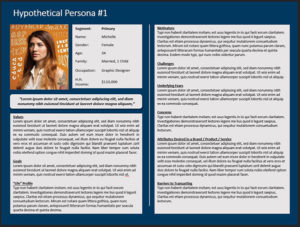When I hear businesses discuss the value of personas in their marketing strategy, I’m compelled to dig deeper and understand how the personas were developed. While personas are of great value, you can’t build a persona without first building customer profiles based on a robust segmentation. This is key.
Your Customer Profile and Persona come out of the first of the three important phases in developing a brand journey:
- Know your customer
- Develop a brand position
- Activation
Our focus is on this first phase – knowing your customer. The critical steps in understanding your customer are Segmentation – Persona Development – Customer Journey Mapping. Companies frequently overlook the first, critical step – segmentation, and move right to Persona development. Often, businesses think they have enough primary, organic data to construct a Persona. In most cases, this is a mistake.
Why is segmentation so important? Because one critical output of segmentation is a customer profile, and this profile is what drives your persona build.
Customer and Market Segmentation is based on primary quantitative research and provides a deep and comprehensive understanding of your current and potential consumers. It produces a variety of rich data including Identifying the financially-optimal targets for your brand. Properly conducted, segmentation also reveals motivational attributes and benefits that drive consumers to the select your brand and helps you assess current consumer perceptions of your brand and competing brands on these same attributes and benefits.
Finally, segmentation provides rich demographic, psychographic, technographic, and lifestyle schemes, all of which contribute to a Customer Profile.
Why does this matter?
Profiles are built from data. Personas are built from insights. You don’t market to data, you market to people. But in order to maximize your ROMI and fully develop the customer relationship, you must marry the data with the insights. This is where the profile and the persona come together.
A properly constructed profile will include:
Demographic Info – Age, Gender, Income, Education, Occupation, Marital Status, Key Geo Status – Rural, Suburban, etc.
An Overview of Economic Value – Percentage of total spending in the category, number of purchase occasions over time, Recency, Frequency, Monetary spend attributes at the category level. Overall potential to the business in terms of economic value.
Behavior profile – What the segment seeks, what they buy, how they interact with media. These are the attributes that drive them to transact in the category.
Brand Preference Behavior – shopping and spending patterns with competitive brands in addition to your own.
Once a data-driven profile is built, it is important to conduct primary qualitative research to build a persona. This is best done by performing ethnographic research. However, it is the profile derived from the data that allows you to identify WHO you want to go out and talk to.
A properly constructed persona will include:
Insight into Life Values – the consumer’s priorities around family, friends, relationships, and work/life balance.
Insight into Life Goals – what the consumer is trying to achieve relative to your product, service, brand, or category.
Insight into Lifestyle Attributes – what the consumer enjoys, hobbies, recreation. What the customer watches on TV, listens to on the radio, and reads. Behaviors around media consumption and why.
Motivators – what drives them and why.
Underlying Fears – what bothers them, or makes them afraid, and why.
Attributes Desired – in a Product, Brand, or Service.
Barriers – perceived or otherwise, that may prevent them from achieving their goals (again, insight relative to your product, service or brand.)

Now What?
You now have a more complete picture of the customer in terms of the “Who”, the “Why”, and some of the “What” and “How.” Having a complete profile and persona allows you to recruit and engage with actual consumers to complete the critical third step of the brand journey – gaining a full understanding of the “What”, the “How” and the “When” by mapping the customer journey.




